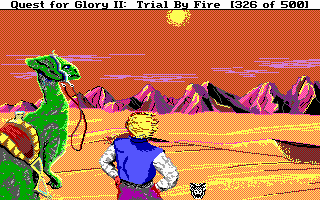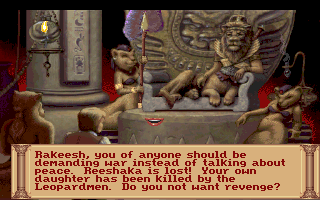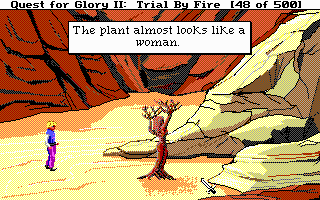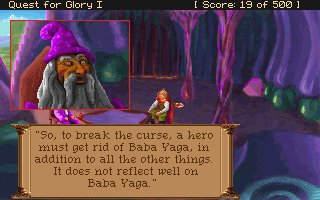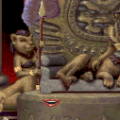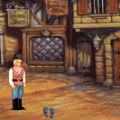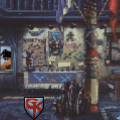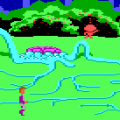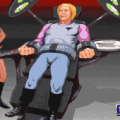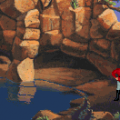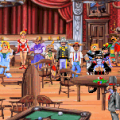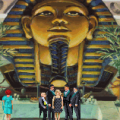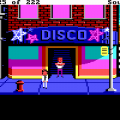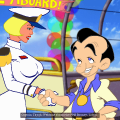Sierra’s Quest for Glory series was designed and programmed by the husband and wife team of Corey and Lori Cole. As avid fans of role-playing games, they melded these mechanics with Sierra adventures with uncannily excellent results. They can be found running The School of Heroes at http://www.theschoolforheroes.com.
How did you both get started at Sierra? Were you fans of adventure games before you’d gotten hired?
I had enjoyed the original (FORTRAN!) Colossal Cave and Zork years before we went to Sierra. I had not played any Sierra games except for a few minutes each with one of the King’s Quest games and Leisure Suit Larry 1. However, Lori and I were (and are) avid paper-and-pencil role-playing gamers. We ran and played in Dungeons & Dragons campaigns. We also liked some computer RPG’s including Rogue and Wizardry.
The Quest for Glory games are far more advanced than most of Sierra’s titles, given their relatively freeform design and how many alternate routes and scenarios can be found. How difficult were they to debug?
We didn’t think of them as “far more” advanced. I was an experienced system programmer before I came to Sierra, so once Lori and I settled on the technical design of the role-playing system, it only took me a few weeks to program it. Since all skill and spell actions went through that layer, I only had to debug it once.
The biggest complexity came from having four character classes with different abilities. That meant we had to test every possible skill and spell in every situation, so it was a burden on the QA department as well as on our programmers. We had some sequencing problems in Quest for Glory III with new Paladins because two rooms were looking for different conditions in what should have been the same sequence of events.
Quest for Glory: Shadows of Darkness turned into a debugging nightmare, but it wasn’t so much because of the game complexity. The system programming department gave us a new version of SCI shortly before we were supposed to ship the game, and it had quite a few problems with pathfinding and simultaneous events. We went from a pretty solid game to a completely broken one, and Sierra ended up shipping it before it was really ready.
In hindsight, we should have missed Christmas and delayed shipment by several months to fix all the problems, but that didn’t happen. Besides being very expensive for the company, the development team was pretty burned out from overtime “crunch mode” by then. They were ready to move on to other projects. Sierra actually devoted a programmer full-time for the next year to prepare the voice version and fix known bugs. The CD version still has some problems, but it’s far cleaner than the floppy disk release. And the voices – especially John Rhys-Davies as the narrator – were awesome! In a perfect world, the second release would have been the only one.
We added more complexity to each of the later games in the series. A typical “room description” might list 5 or 10 “events”, with unique handling for each event. In addition, Sierra programmers developed tools that let us write game text and dialogue without having to modify the source code. I’m sure that prevented a lot of debugging nightmares. We also built a “secret debug mode” into each of the games that allowed testers to set the game state and individual flags so that they could try out each of the events without having to do a full play-through to that point. It was not unusual to get a stack of problem reports six inches thick from the QA/test department.
Each of the QfG games has a very unique feeling – the setting, the characters, the battle system, the music. What do you feel are the strengths of each of the individual games?
QfG1: So You Want to Be a Hero introduced the concept of a hybrid role-playing / adventure game to the industry, so that was certainly unique. Story-wise it was a traditional (in fantasy fiction terms) story about a naive young man coming of age and becoming a Hero. The Germanic setting worked well to give the game a unique flavor. We originally wanted to allow the player to be male or female, and have a choice of character race (including as a Centaur). We were quickly disabused of the notion – the art and animation costs, not to mention the amount of disk space needed for the artwork, would have gone through the roof.
The biggest innovation of the whole QfG series was to combine role-playing game character development and combat with the puzzles and story typical of adventure games. We saw Quest for Glory as our attempt at running a D&D game by computer.
The hero watches the sun in this beautiful cinematic segment.
QfG2: Trial By Fire was probably the strongest game in terms of puzzles and tension. The street maze and nearly endless desert were by far the most complex parts to develop. Kenn Nishiuye did a fantastic job as lead artist, and Jerry Moore created the graphical overlays that let us make a few backgrounds look like many different parts of the desert. I would never design the alleyways the way we did it then – far too frustrating for players – but we succeeded in our goal of making the cities and the desert feel huge.
The Arabian Nights setting for Trial By Fire was a big departure from the traditional medieval European setting that most RPGs used prior to that time. We spent many hours reading the Arabian Nights and crafting interlocking stories and puzzles in that style. QfG2 is also a “message” game in that we pushed the philosophy of the importance of the individual and the need to take a stand when the rules and laws of the society are unjust.
QfG3: Wages of War (later retitled to Seekers of the Lost City, but I’m not sure it was ever actually shipped that way) was one of the strongest games in terms of story and narrative. It has another unique setting – East Africa – and once again contains a message about our philosophy. QfG3 takes a stand against prejudice and racial stereotyping. That makes it a bit ironic, in that we received some complaints about the black people in the game having accents. We were one of the first to include diverse characters including strong female and non-White role models in the game, so we were pretty shocked by that reaction.
The hero makes a detour to the city of Tarna.
QfG4: Shadows of Darkness was the most difficult game (up to that point) to play and to develop. Like QfG2, it is heavily puzzle-oriented, and like QfG3, we put a strong emphasis on the plot line. As the game progresses, the player learns more about the setting, and the attitudes of the people change towards the player character. We had a unique combat system loosely based on Street Fighter, but with a fuzzy logic system to allow non-arcade players to set their fighting style and let their character abilities rather than their twitch skill determine the outcome. Despite the large number of bugs in the initial release, I think QfG4 is my personal favorite of the series or a close second behind QfG2.
QfG5: Dragon Fire was a development nightmare. With the three year lapse since the release of QfG4, we knew that we couldn’t keep using the old technology. As a result, the game engine was redesigned from the ground up to use Voxel graphics (later replaced by traditional 3D graphics) with the rooms programmed in C++ rather than SCI. The design script was about 1,000 pages of detailed explanations for the states and events to be handled in each room. The story and characters were far more complex than in any of the previous games.
Due to the many stylistic changes, some fans of the previous games did not like the look and feel of QfG5. However, I think we also brought in a new audience and stayed true to the narrative and character-centric feel of the rest of the series. We also brought the series to a conclusion rather than leaving it hanging as at the end of most of the previous games.
QfG has some of the best soundtracks of the Sierra games. What kind of themes did you pick to go with them, particularly the awesome rock music from the fourth game?
For all the games except Dragon Fire, the music was created very late in the game development process. As a result, the composer had a chance to look at the game and create a soundtrack that worked well with it. Mark Seibert did the music for QfG1 pretty much on his own. We had approval rights, but the ideas were his. Mark had worked at Sierra for several years and helped create some of the drivers and sound tools, so he had a great feel for what would work in a game.
Chris Braymen did some of the QfG2 music. Chris’s wife did Middle Eastern folk dancing, so Chris was able to incorporate traditional themes into his music and enhance the Arabic flavor of the game. Like Mark, Chris has a technical bent as well as being a talented composer and musician.
Aubrey Hodges came in to compose the music for QfG4 and did a fantastic job of incorporating Slavic themes and at building tension through his musical themes. Lori worked more closely with Aubrey than with the previous composers to make sure he understood what we wanted the game and the music to accomplish.
Finally, Chance Thomas composed and directed the QfG5 music. Sierra brought Chance in much earlier in the process than they did with the previous games. Between that and the many game delays – QfG5 took almost 4 years to develop, versus the original 18 month schedule – Chance was able to hone and polish the game music to a high degree. Lori met frequently with Chance so that he knew every detail of the game scenes as he created the music for them. This process also allowed the team to listen to the music as they polished each scene, so the artists, programmers, and Chance all influenced each other during development.
Since the Quest for Glory games were mostly planned out in advance, how closely did the final product adhere to your original vision, particularly in the case of the fifth game, since it came out so much later? Is there anything you could change about them?
“Mostly planned out in advance” would be an exaggeration. We created a “road map” of the games that laid out the basic themes and settings, and described the general character arc. But it is a very long journey from a game concept to a detailed game design, and finally to a finished, polished game. The original proposal for the Quest for Glory series was about five pages long with lots of illustrations and big bullet points. The final set of design documents for all five games runs to thousands of pages and still doesn’t cover all the details of art, programming, text, and character dialogue in the games.
Lori and I believe that it is impossible to create a great game design up front. The best games come from an iterative development process in which puzzles and story ideas are prototyped and tested. Then the weak ones are discarded and the stronger ones expanded. “No battle plan survives contact with the enemy.” – Helmuth von Moltke the Elder. Many people – particular game company management – hate this idea. They want to know, before game production begins, what the game will involve, how much it will cost to develop, and how many people they need to assign to the project.
But game development is a chaotic process, and needs to be. Many of the best ideas in our games came from someone on the team looking at a prototype and coming up with a crazy idea. Many of those crazy ideas had to be discarded because of cost or because they didn’t fit into the theme of the game, but others became crucial parts of the design. While I have always been known as an incorrigible punster (“Do not incorrige!”), I wasn’t the one who first set the punny tone of the QfG series. That was Bob Fischbach, who prototyped the first QfG scenes and wrote stand-in object descriptions for them. Lori and I liked the feel of Bob’s puns with the cartoony art style of the first game, and we decided to make that a hallmark of the series.
On a related note, one of the most gratifying aspects of the series is how different sub-characters grow, like how Julanar from QfG2 and the apothecary from QfG3 end up married together in QfG5. How far in advance were these crafted? Were there any that were planned but ended up getting cut?
Lori came up with most of the characters and wrote the lion’s share of their dialogue. She came up with a fantasy story explaining Julanar’s background. When we later created Salim, the anachronistic hippy apothecary, it seemed natural that he would be fascinated by Julanar’s story and attracted to her. Lori worked out that romance “off camera”, and later incorporated it into Quest for Glory 5.
The story of Julanar, the tree woman, is one of the most touching in the series.
When we designed each of the later games in the series, we talked about characters from the previous games and whether they would fit in. We generally had an idea of what we wanted to put into the next game in the series, so we could foreshadow it with characters and events in the current game. Occasionally we planned farther ahead – for example, when the hero defeats Baba Yaga in QfG1, we knew that she would return in Shadows of Darkness (originally planned as game 3).
Quest for Glory 3 actually took us by surprise. Ellen Guon (now Ellen Beeman), another designer at Sierra, pointed out that Rakeesh was one of the most interesting characters in QfG2. Ellen suggested that the player should visit his homeland and interact with Rakeesh’s backstory involving a demonic invasion. Since we were concerned that QfG4 would be too dark and difficult a game to follow directly after QfG2, we took her suggestion and developed the land of Tarna in East Africa for QfG3 before taking the player to Mordavia for QfG4.
Quest for Glory is very atypical of most computer RPGs of the time, in that it was heavily focused on narrative. What were some of your inspirations that carried you away from something like Ultima?
We were influenced more by paper-and-pencil roleplaying than by computer games. The first computer RPG’s (such as Temple of Apshai) came with booklets containing the game text. As you entered each room, the game gave you a key number. The booklet gave you a complete description of the room when you looked up the key. That was their way of trying to create a live RPG experience on a computer, and of course was very primitive.
We had a lot more memory to play with, so were able to incorporate the text into the actual game. I think we arrived at exactly the right time in the industry to make the Quest for Glory games. Computers and the SCI game engine had enough power to let us tell stories, but the cost of graphics was still low enough to let us tell them instead of spending the entire game budget on 3D art.
We played a few of the Ultima, Wizardry, The Bard’s Tale, and similar games prior to starting Quest for Glory. While we enjoyed them (especially Wizardry), we felt they were missing the narration that was an essential part of “live” roleplaying. Our goal with Quest for Glory was to make the player feel that they were playing a character in a good live RPG.
Are you familiar with any Japanese console RPGs like Dragon Warrior/Quest or Final Fantasy? Their narrative style, particularly Dragon Quest, is similar to Quest for Glory, especially in how the individual quests have a lot of emotional resonance, which is a big part in making the player feel like a “hero”.
We played some of the Phantasy Star and Final Fantasy games, although that was after we developed the first two games. As a result of pulling many late nights getting QfG2 out the door, the team got a lot of meals from Burger King and The Pizza Factory. We won a Sega Genesis in a Burger King contest, had a drawing to see who would get it, and I won. Otherwise we might never have played a console game. 🙂
What are some of your other favorite adventures games? Are there any other designers or writers whose work you admire?
That would be The Secret of Monkey Island and Ron Gilbert. We met Ron at a couple of Computer Game Developer Conferences; he’s a great guy. Ron admitted that Monkey Island was influenced by Quest for Glory, and his work in turn influenced our later games. He has a fine design and narrative sense; Monkey Island is just plain fun. Other than that, Lori and I played very few adventure games; we generally find the puzzles too difficult and arbitrary. We enjoyed The 7th Guest as a great use of the limited technology of the time to project a mood, as well as having some interesting puzzles.
We generally enjoy role-playing games more than adventure games. I’ve already mentioned Wizardry. We spent many late nights playing Rogue on mainframes and the Atari ST. The original Dungeon Master was a brilliant game. Currently we both spend far too many hours playing World of Warcraft. We think of it as the game Quest for Glory might have become if we’d been able to make a massively-multiplayer version with an infinite budget.
QfG 1, 2 and 4 all let you explore the land on a screen-by-screen basis, but QfG3 solely used an overworld map. Why the shift?
Each game was an experiment. We wanted the East African environment of QfG3 to feel gigantic. The map was our way of showing the player that he was exploring very small parts of a huge jungle and veldt. We used a similar technique in Shannara to try to give the player a feel for the epic scope of Terry Brooks’s world.
There’s a lot of great comedy to be found all of the games. What are some of your favorite jokes and/or death scenes?
We had some fun cameos in QfG2 – the Marx Brothers, the “Persian Golfer” reference to the first Gulf War, and so on. QfG3 continued the trend with the Awful Waffle Walker and Arne the Aardvark (a strangely twisted reference to Journey to the Center of the Earth and the Cerebus graphic novels). I thought the interactions between Fenris and Erasmus were fun. We also had lots of throw-away pop culture references to Monty Python, and other Sierra games.
We tried not to emphasize the death scenes; we didn’t want the player to die very often. But we had fun with some of them, such as the Rusalka in QfG4, getting killed by the Antwerp in QfG1, and a few others. Incidentally, the name “Antwerp” came from a very ticklish friend of ours who used Antwerp as a “safe word” to mean, “This is no longer fun.” We remembered that and thought that Antwerp is a silly-sounding name in English, so we used it for the silly bouncing creatures in QfG1.
The slightly draft wizard Erasmus and his talking rat Fenris provide much amusement.
How did you get involved in working with Legend Entertainment on Shannara?
We met Bob Bates, President of Legend, each year at the CGDC (Computer Game Developers Conference). We had heard each other talk about game design, and had a lot of mutual respect. When Sierra broke our contract after QfG4 shipped, Bob suggested that we make a game for Legend. As is usual on such deals, he asked us for ten game ideas, then ended up assigning us to Shannara when Legend got the license to use it in a game. We read through the first few books, came up with a game concept, then met with Terry Brooks and Random House to get their approval. We tried to create a unique story within the world of Shannara, while not doing anything that would interfere with the events of the later books.
Do you have any future plans for Quest for Glory, or other similar types of role playing games or stories?
Activision, Sierra’s parent company, owns all rights to Quest for Glory and appears to have no interest in developing more games in the series. Lori and I have done some initial design for a text adventure game with very limited graphics based on our School for Heroes, but we’ve stalled several times on the actual development. We would like to do that game at some point, but haven’t yet pushed ourselves to do it. Our main focus these days is http://www.theschoolforheroes.com, where we help students develop their own “inner Hero” using fantasy gaming concepts. I write a blog (http://www.theschoolforheroes.com/ questlog) on topics related to heroism, personal achievement, and occasionally game design. I may move the blog to a new site that will include some simple games to help people plan and improve their lives. Lori has her own site and art blog, http://www.farstudio.net/gallery, to which she posts her photographic art and commentary.


